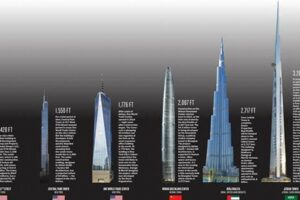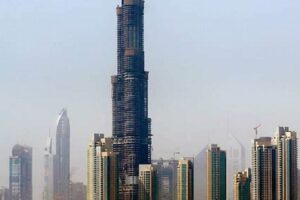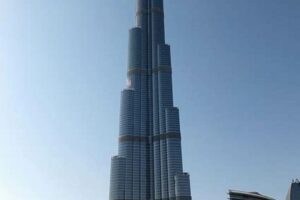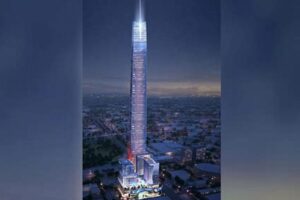The tallest skyscraper in the world is a building that has the most floors and the greatest height. It is a remarkable feat of engineering and architecture, pushing the boundaries of human ingenuity and construction capabilities. The title of the tallest skyscraper in the world has been held by various buildings throughout history, as new architectural marvels are constructed, each striving to surpass its predecessors in height and grandeur.
The current title holder of the tallest skyscraper in the world is the Burj Khalifa, located in Dubai, United Arab Emirates. Standing at an impressive 828 meters (2,717 feet) tall, with 163 floors, the Burj Khalifa has been an iconic landmark since its completion in 2010. It serves as a testament to human ambition and the continuous pursuit of architectural excellence.
The race to build the tallest skyscraper in the world is a continuous one, with architects and engineers constantly striving to create even taller and more impressive structures. This pursuit not only tests the limits of construction but also pushes the boundaries of design and innovation, leading to advancements in materials, engineering techniques, and architectural aesthetics.
1. Height
In the realm of skyscrapers, height reigns supreme as the defining characteristic that sets these architectural wonders apart. Measured in meters or feet, a skyscraper’s vertical reach is a testament to human ambition and engineering prowess. When we consider “which is the tallest skyscraper in the world,” height becomes the primary criterion for comparison and distinction.
- Height as a Symbol of Prestige: Skyscrapers have long been associated with power, wealth, and economic dominance. The height of a skyscraper often reflects the aspirations and ambitions of the city or country it resides in, becoming a symbol of progress and prosperity.
- Engineering Challenges and Innovations: Constructing a skyscraper that defies gravity requires exceptional engineering skills and innovative solutions. Architects and engineers must overcome challenges related to structural stability, wind resistance, and material strength to achieve greater heights, pushing the boundaries of architectural possibility.
- Vertical Space Optimization: Height is not merely about reaching for the sky; it also presents opportunities for efficient space utilization. Skyscrapers provide ample vertical space, allowing for a variety of uses within a single structure, from residential units to office spaces, retail outlets, and recreational facilities.
- Urban Planning and Skyline Aesthetics: The height of a skyscraper significantly impacts the urban landscape and skyline aesthetics. Taller skyscrapers create new focal points, alter the city’s skyline profile, and can serve as landmarks visible from afar, shaping the overall character and identity of a city.
In conclusion, the height of a skyscraper is not just a numerical value; it is a multifaceted aspect that encompasses prestige, engineering prowess, space optimization, and urban aesthetics. When we seek to determine “which is the tallest skyscraper in the world,” we are not merely comparing numbers; we are acknowledging the culmination of human ingenuity, innovation, and the relentless pursuit of architectural excellence.
2. Floors
In the context of “which is the tallest skyscraper in the world,” the number of floors plays a crucial role in determining a skyscraper’s height and overall functionality. Each floor represents an additional level within the skyscraper, providing valuable space for a diverse range of purposes.
- Vertical Space Utilization: Skyscrapers offer a unique solution to the scarcity of land in densely populated urban areas. By building upwards, skyscrapers maximize vertical space utilization, accommodating a significant number of occupants and functions within a relatively small footprint.
- Mixed-Use Developments: Modern skyscrapers often incorporate mixed-use developments, combining residential, commercial, retail, and hospitality spaces within a single structure. This vertical integration creates vibrant and self-sufficient urban environments, catering to a wide range of needs.
- Functional Diversity: The number of floors in a skyscraper allows for a greater degree of functional diversity. Different floors can be dedicated to specific purposes, such as office spaces, residential apartments, hotel rooms, conference halls, or recreational facilities.
- Height and Floor Count Correlation: While not a direct correlation, the number of floors generally contributes to the overall height of a skyscraper. Taller skyscrapers tend to have more floors to distribute their height and maintain structural integrity.
In conclusion, the number of floors in a skyscraper is not merely a numerical figure; it is a crucial factor that influences the building’s height, functionality, and overall design. By providing vertical space utilization, mixed-use developments, functional diversity, and a correlation to height, the number of floors plays a vital role in shaping the identity and purpose of the world’s tallest skyscrapers.
3. Location
When considering “which is the tallest skyscraper in the world,” the geographical location plays a significant role. Skyscrapers, particularly the tallest ones, tend to be concentrated in major cities or financial hubs for several reasons:
- Economic Factors: Major cities and financial hubs are often centers of economic activity, attracting businesses, investments, and a large workforce. The presence of corporations, financial institutions, and high-net-worth individuals creates a demand for premium office space and luxury residential units, driving the construction of tall buildings.
- Land Availability and Value: In densely populated urban areas, land is a scarce resource. Skyscrapers offer a solution by maximizing vertical space utilization, allowing for a significant number of occupants and functions within a relatively small footprint. This makes them economically viable in locations where land prices are high.
- Transportation and Infrastructure: Major cities and financial hubs typically have well-developed transportation networks, including airports, highways, and public transportation systems. This connectivity is crucial for skyscrapers, which require efficient access for occupants, visitors, and the movement of goods and services.
- Urban Prestige and Identity: Skyscrapers have become symbols of urban power, prosperity, and architectural prowess. Cities often compete to construct the tallest buildings, as they serve as landmarks and contribute to the overall prestige and identity of the city.
In conclusion, the geographical location of a skyscraper, particularly in major cities or financial hubs, is closely intertwined with the factors that drive the construction of the world’s tallest buildings. Economic opportunities, land availability, transportation infrastructure, and urban prestige all converge to make these locations the preferred destinations for the most ambitious skyscraper projects.
4. Design
When examining “which is the tallest skyscraper in the world,” the architectural design and aesthetics play a crucial role in shaping the identity and appeal of these towering structures. Design goes beyond mere aesthetics; it encompasses the creative vision, functional considerations, and engineering prowess that come together to create a skyscraper that is both visually striking and structurally sound.
The design of a skyscraper often reflects the architectural style prevalent at the time of its construction. Art Deco, Gothic Revival, and Modernist influences have all left their mark on the world’s tallest buildings. The Burj Khalifa, for example, showcases a contemporary interpretation of Islamic architecture, while the One World Trade Center in New York City incorporates elements of Gothic Revival and Art Deco styles.
Beyond aesthetics, the design of a skyscraper must also consider functional and engineering requirements. The shape and structure of the building must ensure its stability and withstand various environmental forces, including wind, earthquakes, and potential fires. Architects and engineers work closely to optimize the design for both form and function, creating structures that are not only visually impressive but also safe and habitable.
The design of a skyscraper also contributes to its overall height. Innovative structural systems and the use of lightweight materials allow architects to push the boundaries of vertical construction. The Burj Khalifa’s unique buttressed core design, for example, played a crucial role in achieving its record-breaking height.
In conclusion, the design of a skyscraper is not merely about aesthetics; it is a complex interplay of creativity, functionality, and engineering excellence. When considering “which is the tallest skyscraper in the world,” the design plays a fundamental role in shaping the building’s identity, functionality, and overall appeal.
5. Materials
The choice of materials used in the construction of a skyscraper plays a critical role in determining its height and overall performance. The strength, durability, and aesthetic appeal of the materials used directly influence the building’s ability to withstand various forces and environmental conditions, contributing to its overall success as one of the world’s tallest structures.
Concrete, steel, and glass are the most commonly used materials in skyscraper construction, each offering unique advantages. Concrete provides exceptional compressive strength and fire resistance, making it ideal for the core and foundation of tall buildings. Steel, known for its high strength-to-weight ratio, is often used for the framework and exterior cladding, allowing for lighter and more slender structures. Glass, with its transparency and reflective properties, contributes to the aesthetics and energy efficiency of the building.
In the race to build the tallest skyscraper in the world, architects and engineers are constantly pushing the boundaries of material science and engineering. They explore innovative ways to combine traditional materials with advanced composites and lightweight alloys to create structures that are both strong and visually striking. The Burj Khalifa, for example, utilizes a high-performance concrete mix and a reinforced steel structure to achieve its record-breaking height.
The selection of materials also affects the appearance and architectural style of the skyscraper. Glass facades, for instance, offer panoramic views and create a sense of transparency and lightness, while concrete and steel structures can convey a more solid and monumental aesthetic. The interplay of materials and design contributes to the unique identity and appeal of each skyscraper.
In conclusion, the choice of materials in skyscraper construction is a crucial factor in determining “which is the tallest skyscraper in the world.” The strength, durability, and aesthetic properties of the materials used directly impact the building’s ability to reach new heights and withstand the challenges of the environment. As architects and engineers continue to innovate and explore new materials, we can expect even more ambitious and awe-inspiring skyscrapers to grace the skylines of the world.
6. Engineering
The pursuit of constructing the world’s tallest skyscraper is inherently intertwined with the advancement of innovative engineering techniques. Engineering plays a critical role in ensuring the structural integrity and stability of these towering structures, allowing them to withstand various forces and environmental challenges.
One of the key engineering considerations in skyscraper construction is the development of efficient structural systems. These systems must be able to distribute the weight of the building evenly, resist lateral forces such as wind and earthquakes, and maintain the building’s stability under different loading conditions. Engineers employ advanced computer modeling and analysis techniques to optimize structural designs, ensuring that the skyscraper can withstand the forces it will encounter throughout its lifetime.
Another crucial aspect of skyscraper engineering is the use of high-performance materials. These materials, such as reinforced concrete, structural steel, and composite materials, provide the necessary strength, durability, and flexibility to support the immense weight and height of the building. Engineers carefully select and combine these materials to create structures that are not only strong but also lightweight, allowing for greater heights to be achieved.
Wind engineering is another critical field of engineering in skyscraper construction. Tall buildings are particularly susceptible to wind forces, which can cause swaying and structural damage if not properly accounted for. Engineers conduct extensive wind tunnel testing and employ aerodynamic design features to minimize the impact of wind on the building. They incorporate elements such as setbacks, tapered facades, and tuned mass dampers to reduce wind-induced vibrations and ensure the comfort and safety of occupants.
In conclusion, the engineering behind the world’s tallest skyscrapers is a testament to human ingenuity and the continuous pursuit of architectural excellence. Innovative engineering techniques, coupled with advanced materials and rigorous analysis, enable the construction of structures that reach new heights, redefine skylines, and push the boundaries of architectural possibility.
7. Purpose
The intended purpose of a skyscraper plays a significant role in determining “which is the tallest skyscraper in the world.” The specific use of the building influences its design, height, and overall functionality.
Commercial skyscrapers, primarily designed for office spaces, tend to be taller than residential skyscrapers. This is because businesses often seek to occupy high floors to take advantage of panoramic views and natural light, which can enhance employee productivity and well-being. Commercial skyscrapers also often incorporate retail spaces on lower floors, creating a vibrant urban environment.
Residential skyscrapers, on the other hand, prioritize comfortable living spaces with amenities such as fitness centers, swimming pools, and green spaces. They may not reach the same heights as commercial skyscrapers but offer a luxurious and convenient living experience for urban dwellers.
Mixed-use skyscrapers combine commercial and residential uses, creating a diverse and self-sufficient urban environment. These buildings offer a blend of office spaces, residential units, retail outlets, and recreational facilities, catering to a wide range of needs within a single structure.
Understanding the purpose of a skyscraper is crucial for architects and engineers to optimize its design and functionality. By carefully considering the intended use, they can create structures that not only reach new heights but also meet the specific needs of occupants and contribute to the overall vitality of the urban environment.
8. Symbolism
The pursuit of constructing the world’s tallest skyscraper is often intertwined with a desire to create a symbolic landmark that embodies a city’s economic strength and architectural achievements. Skyscrapers have become iconic representations of urban power, technological advancement, and cultural identity.
When people ask “which is the tallest skyscraper in the world,” they are not merely inquiring about a building’s height; they are also seeking to identify the city or country that has demonstrated the economic and engineering prowess to construct such an architectural marvel. The tallest skyscraper becomes a symbol of that city’s ambition, innovation, and place on the global stage.
For example, the Burj Khalifa in Dubai has become synonymous with the city’s rapid growth and economic prosperity. Its towering height and distinctive design have made it an instantly recognizable landmark, symbolizing Dubai’s transformation into a global business and tourism hub.
Similarly, the Shanghai Tower in China stands as a testament to the country’s economic and technological advancements. Its unique spiral shape and sustainable design elements reflect China’s commitment to innovation and environmental responsibility.
Understanding the symbolic significance of skyscrapers is crucial for appreciating their role in shaping urban landscapes and cultural identities. These architectural giants serve as physical manifestations of a city’s aspirations, achievements, and place in the world.
9. Evolution
The historical development of skyscrapers is intrinsically connected to the quest for “which is the tallest skyscraper in the world.” Tracing the origins and continuous drive to build taller structures provides valuable insights into the factors that have shaped this architectural phenomenon.
- Technological Advancements: Innovations in engineering, materials, and construction techniques have pushed the boundaries of what is structurally possible, enabling the construction of ever-taller skyscrapers. The development of steel frames, reinforced concrete, and high-strength materials has played a pivotal role in achieving greater heights.
- Economic Factors: The pursuit of economic growth and urban development has fueled the construction of skyscrapers, particularly in major cities. Skyscrapers offer a compact and efficient way to accommodate a large number of people and businesses within a limited urban footprint, maximizing land use and generating revenue.
- Architectural Ambition: The desire to create iconic landmarks and architectural masterpieces has motivated architects and engineers to push the limits of design and innovation. Skyscrapers have become symbols of a city’s economic power, cultural identity, and architectural prowess, inspiring awe and admiration.
- Cultural Influences: Cultural and historical factors have influenced the design and development of skyscrapers. From the Art Deco skyscrapers of the early 20th century to the sustainable skyscrapers of today, cultural trends and societal values have shaped the aesthetic and functional aspects of these towering structures.
Understanding the evolution of skyscrapers provides a deeper appreciation for the architectural marvels that grace our skylines today. The continuous drive to build taller structures is a testament to human ingenuity, technological advancements, and the desire to create iconic landmarks that reflect the aspirations and achievements of our societies.
Which is the tallest skyscraper in the world FAQs
This section addresses frequently asked questions about the tallest skyscrapers in the world, providing concise and informative answers to common queries.
Question 1: Which building currently holds the title of the tallest skyscraper in the world?
As of 2023, the Burj Khalifa in Dubai, United Arab Emirates, stands as the tallest skyscraper in the world, with a height of 828 meters (2,717 feet) and 163 floors.
Question 2: What are the key factors that determine the height of a skyscraper?
The height of a skyscraper is primarily determined by engineering advancements, the availability of high-strength materials, efficient structural systems, and economic considerations related to land use and construction costs.
Question 3: How has the concept of the tallest skyscraper evolved over time?
The concept of the tallest skyscraper has evolved significantly over time, influenced by technological advancements, architectural styles, and cultural factors. From the early skyscrapers of the 19th century to the supertall skyscrapers of today, the pursuit of height has been intertwined with human ambition and the desire to create architectural landmarks.
Question 4: What are the main purposes of skyscrapers?
Skyscrapers serve various purposes, including providing office space for businesses, residential units for urban dwellers, and mixed-use developments that combine commercial, residential, and retail spaces. They offer efficient land utilization, panoramic views, and modern amenities, making them attractive options in densely populated urban centers.
Question 5: What are the engineering challenges involved in constructing skyscrapers?
Constructing skyscrapers involves overcoming engineering challenges related to structural stability, wind resistance, seismic activity, and fire safety. Engineers employ innovative structural systems, advanced materials, and sophisticated analysis techniques to ensure the safety and integrity of these towering structures.
Question 6: How do skyscrapers contribute to the urban environment?
Skyscrapers can significantly impact the urban environment by creating vertical communities, reducing urban sprawl, and serving as landmarks that enhance the city’s skyline. They can also promote sustainable practices through energy-efficient designs and green building technologies.
In conclusion, the pursuit of the tallest skyscraper in the world is driven by a combination of technological advancements, architectural innovation, and economic factors. Skyscrapers continue to shape urban landscapes and serve as symbols of human ingenuity and the desire to reach new heights.
Transition to the next article section: Understanding the significance and impact of the tallest skyscrapers in the world.
Tips for Understanding the World’s Tallest Skyscrapers
To fully appreciate the significance and impact of the world’s tallest skyscrapers, consider the following tips:
Examine Architectural Design: Analyze the unique architectural features, materials, and structural systems employed in these towering structures. Consider how these elements contribute to their stability, aesthetics, and overall impact on the cityscape.
Understand Engineering Innovations: Explore the innovative engineering techniques used to overcome challenges such as wind resistance, seismic activity, and structural integrity. Appreciate the role of advanced materials and sophisticated analysis methods in enabling the construction of these vertical marvels.
Consider Urban Impact: Evaluate the impact of skyscrapers on the urban environment. Examine how they contribute to vertical communities, reduce urban sprawl, and serve as landmarks that enhance the city’s skyline. Analyze their potential role in promoting sustainable practices and fostering a sense of community.
Explore Cultural Significance: Recognize the cultural and symbolic significance of skyscrapers. Understand how they reflect a city’s economic power, technological advancements, and architectural prowess. Consider how they shape urban identity and contribute to the city’s overall image.
Appreciate Historical Evolution: Trace the historical development of skyscrapers, from their origins to the present day. Examine how technological advancements, architectural styles, and economic factors have influenced the design and construction of these towering structures. Understand the motivations and aspirations that have driven the pursuit of height.
By incorporating these tips into your understanding, you can gain a deeper appreciation for the architectural significance, engineering prowess, and cultural impact of the world’s tallest skyscrapers.
Conclusion: The pursuit of the tallest skyscraper in the world is a testament to human ingenuity, technological advancements, and the desire to create architectural landmarks that push the boundaries of possibility. By understanding the various facets of these towering structures, we can appreciate their profound impact on our cities, cultures, and the human experience.
Conclusion
The pursuit of “which is the tallest skyscraper in the world” has driven architectural innovation, engineering advancements, and the creation of iconic landmarks that redefine our skylines. The world’s tallest skyscrapers stand as testaments to human ingenuity, technological prowess, and the relentless drive to push the boundaries of construction.
These towering structures embody the economic power, cultural aspirations, and architectural achievements of the cities they reside in. They serve as symbols of progress, innovation, and the human desire to reach new heights. As we continue to explore the limits of architectural possibility, the pursuit of the tallest skyscraper will undoubtedly continue, inspiring awe and admiration for generations to come.







